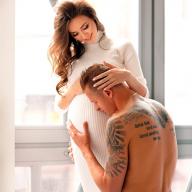There are three main versions that explain why men and women fasten their clothes on different sides:
1. The custom of sewing fasteners on the left side of women's clothing comes from the Middle Ages. Then buttons in Europe served as decoration and were made of precious metals. Made of gold, silver and ivory, they symbolized wealth and a high position in society. Only the nobles could afford such a luxury. It was not customary for noble ladies in those days to dress themselves, they were helped by maids. For the convenience of the servants, the buttons were located on the right, but in relation to the fastener. On clothes, they were sewn on the left.
Men, even of a noble family, more often dressed themselves, and therefore it was easier for them to fasten the buttons on the right. In addition, European aristocrats in those days often had to fight. And if necessary, an armed man had the opportunity to warm his right hand, in which he held a weapon, under the left hollow garment.
2. According to another version, buttons were sewn on from different sides, so that women's and Men's shirts could not be confused.
3. There is a third version, according to which it is more convenient for nursing mothers to hold babies with their left hand and feed with their left breasts so that their right hand remains free for other things. At the same time, the child could be covered from the cold with the right hollow clothing.
On which side were buttons sewn in Russia?
At times Ancient Russia men's shirt-kosovorotka fastened on the left side. Until the first half of the 20th century, gymnasts were also fastened to the left.
On men's and women's things, buttons are located on different floors. You put on a guy's shirt, reach for the usual fastener, and the buttons are located on the other side. Yes, and the thing is fastened in the opposite direction. Unusual, uncomfortable, but there's nothing to be done. Why this is done - let's figure it out together.
 Strict differences in fastening buttons can be observed not only on shirts. There are also buttons on opposite floors of coats, jackets, cardigans and other similar things. On objects women's wardrobe buttons are on the left. Accordingly, the thing is wrapped on the left side. In menswear, everything is exactly the opposite.: buttons are placed on the right side, and the item fastens on the right side. You can remember the differences with the help of the following phrase: “a man has such a smell that he can get a dagger from under his clothes right hand».
Strict differences in fastening buttons can be observed not only on shirts. There are also buttons on opposite floors of coats, jackets, cardigans and other similar things. On objects women's wardrobe buttons are on the left. Accordingly, the thing is wrapped on the left side. In menswear, everything is exactly the opposite.: buttons are placed on the right side, and the item fastens on the right side. You can remember the differences with the help of the following phrase: “a man has such a smell that he can get a dagger from under his clothes right hand».
Important! It is interesting that differences are observed not only in the case of buttons, but also with lightning. The tongue on men's clothes is on the right side.
Why are these differences with women's clothing necessary?
There are several versions of why men fasten things to the left. All of them are "rooted" in ancient times and are more guesses than proven facts. However, each of them has the right to exist. For instance:

At the moment, all versions are far in the past. Now the location of the buttons on the right on men's things is a tribute to tradition, and not an obligatory element of the structure of clothing.
The differences were not only in the richness and intricacy of the clothes, but also in the way they were put on. Ladies from high society were always dressed by maids. This began in the era of corsets, which had to be pulled tight on a woman's back, which only servants could do. The lady herself was absolutely helpless when it came to putting on a corset and a dress.
This tradition has been preserved until the use of buttons as fasteners. When buttons appeared on the dresses of aristocrats, they quite naturally began to be sewn only on the left side. So the maid standing in front of her mistress, it was more convenient to fasten her clothes. On men's robes, buttons were sewn on the right, because even noble gentlemen fastened their camisoles on themselves and generally dressed on their own.
Since the majority of people on Earth are still right-handed (about 85%), the way they use buttons was “customized” to their needs. The described customs existed for so long that they gradually turned into a stable tradition. So far the buttons on women's clothing sewn on the left, and on the male - on the right.
No man will wear a shirt with buttons sewn on the left side. Simply because in this case it is female. Indeed, on items from the women's wardrobe, buttons are usually sewn on the left side, and on the men's items - on the right.
Where exactly this feature came from is not exactly known, but it probably originates from a time when people wore much more complex and richly decorated clothes than they do now. These days, girls dress themselves, but from the Renaissance to the Victorian era, girls from well-to-do families could afford a servant to dress them before going out. Often, the clothes contained so many small details and nuances that it was extremely difficult to properly put on the entire set on your own. And it was much easier for helping servants to fasten their clothes if the buttons were sewn on the left side (in the case when the assistant was facing the girl, as most often happened). Men at all times preferred to dress themselves.
Of course, the question arises why such a small group of people who could afford to keep servants set the fashion for everyone else? But this is not surprising: the upper class has always been the source of fashion trends for the middle and lower class (for example, visual).
Another popular explanation is that in the past, it was mandatory for a man to carry a weapon with him. It is assumed that men wore clothes with buttons on the right side in order to hold weapons with their right hand, and unfasten them with their left hand if necessary. outerwear and get necessary thing(It is much easier to unbutton buttons sewn on the right side of the shirt with your left hand than with your left hand on the left side). And in the more distant past, when they fought with swords, the standard fighting stance involved the left leg put forward, the shield in the left hand and the weapon in the right. Meeting the enemy, the protective shirt was buttoned with an overlap not from right to left, otherwise the enemy sword could find a gap, but from left to right.
But, perhaps, it's not at all about fashion or carrying weapons, but about small children? After all, when a woman wears baby, she prefers to hug him with her left hand while feeding him with her free right. It is likely that it was for this purpose that the buttons on women's clothing began to be sewn on the left side.
Be that as it may, the method of fastening clothes in our time is distributed by gender, and in modern stores it is often the place where buttons are sewn on that helps to distinguish men's clothing from women's clothing.
If you find an error, please highlight a piece of text and click Ctrl+Enter.
At a certain age, each of us learns that men's and women's clothing fastens in different directions. At first, it was quite difficult for me to learn which side women's clothes (as well as men's) are fastened on, it seemed easier to remember which side of the buttons on clothes. It's just that I'm one of those people who, at the mention of "left", always first remembers where the left hand is.
On women's clothing, buttons are on the left side, and clothes are fastened on the left side.

Men's clothes have buttons on the right side, and clothes are fastened on the right side.

Zip fasteners male side.

By the way, if there is one breast pocket, then it is performed on the left side.
Why this way and not otherwise, history evasively offers several options to choose from. Moreover, there is no alternative. Men's clothing began to fasten on the right side by itself, and women's on the left due to objective reasons, with menswear unrelated.
However, today the fashion is quite democratic and you can easily find a clasp on the "male" side on women's clothing, especially in trousers. This is easy to understand, because it is much more convenient to unzip the zipper with your right hand.





